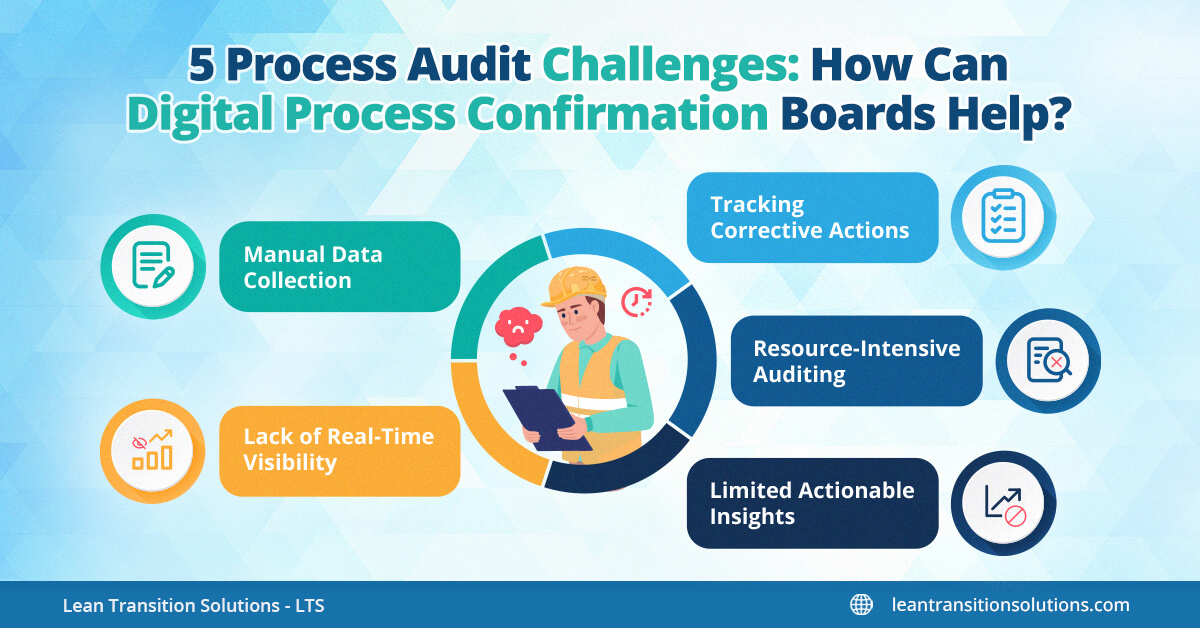5 Common Challenges in Process Audits—and How Digital Confirmation Boards Solve Them
February 7, 2025
Using the wrong kind of milk for coffee, brewing at a low temperature, or neglecting regular machine cleaning are common challenges you might face when relying on a coffee-making machine. Do you think these problems are easily noticeable? Probably not. You need to closely monitor the machine's health, the brewing process, and the serving quality—essentially conducting a process audit. We understand this isn’t an easy task; it’s repetitive, requires reconfirmation and rectification, and must remain relevant. That’s why we’ve developed our digital process audit tools. Are you after that one magical platform which can reduce manual errors in process audits with digital tools? Read on to explore the five common challenges of process audits and how digital confirmation boards can address them.
What Are Process Audits and the Common Problems with Paper-Based Auditing?
Process audits are crucial for ensuring organisational workflows comply with established standards, improving efficiency, and identifying areas for optimisation and enhancing workflow visibilty. They provide a structured approach to assess the effectiveness of processes, minimise risks, and maintain quality control. However, traditional process audits often struggle with manual data collection, which is time-consuming and prone to errors, a lack of real-time visibility, and challenges in tracking corrective actions. These audits can also be resource-intensive and often fail to deliver actionable insights promptly, limiting their effectiveness in driving continuous improvement. Wondering how to streamline process audits with digital confirmation boards?
Auditing is often seen as a “black-letter day” event—something dreaded but essential. It identifies, verifies, and corrects issues within processes. The stress often arises from auditors dissecting every detail, but this can be alleviated with the right digital tools for process audits, such as TCards for process confirmation, also known as Digital Kamishibai Boards. Want to join us in improving workflow visibility with process confirmation boards?
Auditing is often seen as a “black-letter day” event—something dreaded but essential. It identifies, verifies, and corrects issues within processes. The stress often arises from auditors dissecting every detail, but this can be alleviated with the right digital tools for process audits, such as TCards for process confirmation, also known as Digital Kamishibai Boards. Want to join us in improving workflow visibility with process confirmation boards?
Why Do We Need Digital Process Confirmation Boards?
Digital process confirmation boards streamline and improve process audits by providing a clear, visual representation of workflows, enabling real-time tracking of tasks and progress. These tools simplify data collection, eliminate errors associated with manual methods, and provide instant updates and actionable insights. They allow auditors to quickly identify deviations from standard processes, track corrective actions effectively, and ensure accountability. With features like transparency, automation, and ease of integration, digital confirmation boards make audits more efficient, reduce resource demands, and promote continuous process improvement. If you are in your search for a solution for automating process audits with confirmation boards, we are your best bet. Explore our digital tools to solve common process audit issues and start tracking corrective actions in process audits efficiently.
The Challenges in Process Audits and How Digital Process Confirmation Boards (PCB) Help
1. Manual Data Collection
Traditional audits rely on manual data entry, which is time-consuming, prone to errors, and can delay the process.
Auditors may struggle to access real-time insights, making it difficult to identify and address issues immediately.
Monitoring the completion of corrective actions can be challenging, leading to delays in addressing inefficiencies.
Traditional audits often require significant time and resources for data collection and analysis.
Paper-based audits often lack the depth of insights needed for meaningful improvements.
Traditional audits rely on manual data entry, which is time-consuming, prone to errors, and can delay the process.
- How PCB Helps: Digital boards enable real-time data capture, reducing manual effort and minimising the risk of errors.
Auditors may struggle to access real-time insights, making it difficult to identify and address issues immediately.
- How PCB Helps: Digital boards provide real-time tracking and global accessibility with live updates and a clear, visual overview of processes, allowing timely interventions.
Monitoring the completion of corrective actions can be challenging, leading to delays in addressing inefficiencies.
- How PCB Helps:Digital boards facilitate efficient tracking and status updates for corrective actions, ensuring timely resolution.
Traditional audits often require significant time and resources for data collection and analysis.
- How PCB Helps:By automating data capture and reporting, digital boards reduce the need for extensive manual labour, making audits more resource efficient.
Paper-based audits often lack the depth of insights needed for meaningful improvements.
- How PCB Helps:Digital boards offer detailed data visualisation, helping teams identify patterns, bottlenecks, and areas for improvement effortlessly.
What are the Benefits of Using Process Confirmation Boards for Process Audits?
- Improved Accuracy: Automates data collection, reducing human errors and ensuring precise records.
- Real-Time Monitoring: Provides instant updates on tasks, deviations, and progress, allowing immediate corrective action.
- Enhanced Efficiency: Streamlines the auditing process, saving time and reducing resource usage.
- Clear Visual Representation: Displays workflows and audit statuses in an easy-to-understand format for better decision-making.
- Effective Corrective Action Tracking: Tracks and monitors the status of corrective measures, ensuring timely implementation.
- Data-Driven Insights: Generates actionable insights for identifying patterns, bottlenecks, and areas for improvement.
- Transparency and Accountability: Enhances visibility and ensures stakeholders are informed and accountable.
- Customisation Options: Adaptable to various industries and processes, allowing tailored solutions for specific audit needs.
- Reduced Paperwork: Eliminates manual records, contributing to a sustainable and clutter-free environment.
- Continuous Improvement: Promotes ongoing optimisation of processes through regular updates and proactive monitoring.
Transform Your Process Audits Today with Digital Confirmation Boards!
Process audits are essential for maintaining compliance and improving efficiency, but traditional methods fall short due to errors, inefficiencies, and a lack of actionable insights. Digital confirmation boards tackle these challenges by offering real-time tracking, automation, and data-driven insights that simplify and enhance the audit process. By adopting this innovative technology, businesses can streamline workflows, improve accountability, and foster a culture of continuous improvement. Make the shift to smarter audits today and unlock your organisation's full potential!
FAQ's
1. What are process audits, and why are they important?
Process audits are systematic examinations of workflows, procedures, and operations to ensure compliance, efficiency, and alignment with organisational standards. They help identify inefficiencies, risks, and opportunities for improvement.
2. What are some common challenges faced during process audits?
Key challenges include:
Digital confirmation boards centralise communication by enabling real-time updates, task tracking, and collaborative feedback loops, ensuring all stakeholders are aligned throughout the audit process.
4. Can digital confirmation boards reduce errors in documentation?
Yes, digital confirmation boards automate data capture and streamline record-keeping, minimising manual entry errors and ensuring accuracy in documentation.
5. Are digital confirmation boards suitable for all types of organisations?
Absolutely. Digital confirmation boards are scalable and customisable, making them ideal for organisations of all sizes across various industries seeking efficient and transparent audit processes.
Process audits are systematic examinations of workflows, procedures, and operations to ensure compliance, efficiency, and alignment with organisational standards. They help identify inefficiencies, risks, and opportunities for improvement.
2. What are some common challenges faced during process audits?
Key challenges include:
- Difficulty in tracking and validating data.
- Lack of real-time insights.
- Communication gaps among stakeholders.
- Manual errors in documentation.
- Limited access to historical audit records.
Digital confirmation boards centralise communication by enabling real-time updates, task tracking, and collaborative feedback loops, ensuring all stakeholders are aligned throughout the audit process.
4. Can digital confirmation boards reduce errors in documentation?
Yes, digital confirmation boards automate data capture and streamline record-keeping, minimising manual entry errors and ensuring accuracy in documentation.
5. Are digital confirmation boards suitable for all types of organisations?
Absolutely. Digital confirmation boards are scalable and customisable, making them ideal for organisations of all sizes across various industries seeking efficient and transparent audit processes.
